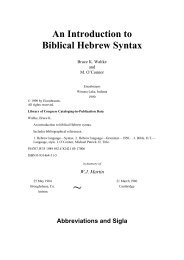a definite rule for the use of the article in the greek new testament
a definite rule for the use of the article in the greek new testament
a definite rule for the use of the article in the greek new testament
Create successful ePaper yourself
Turn your PDF publications into a flip-book with our unique Google optimized e-Paper software.
as a predicate with <strong>the</strong> <strong>article</strong> 5 , <strong>in</strong> each <strong>of</strong> <strong>the</strong> thirteen passages <strong>the</strong>y follow <strong>the</strong><br />
verb. These words also appear ten times as predicate nom<strong>in</strong>atives without <strong>the</strong><br />
<strong>article</strong>, <strong>in</strong> n<strong>in</strong>e <strong>of</strong> <strong>the</strong>se passages <strong>the</strong>y precede <strong>the</strong> verb 6 and <strong>in</strong> <strong>the</strong> tenth<br />
(Mat<strong>the</strong>w 27:13) it may be significant that qeou/ precedes <strong>the</strong> verb.<br />
The title “Son <strong>of</strong> Man” appears twice <strong>in</strong> <strong>the</strong> New Testament as a<br />
predicate nom<strong>in</strong>ative: once with <strong>the</strong> <strong>article</strong> (Mat<strong>the</strong>w 13:37) and once without<br />
<strong>the</strong> <strong>article</strong> (John 5:27). In <strong>the</strong> Mat<strong>the</strong>an passage, where it has <strong>the</strong> <strong>article</strong> it<br />
follows <strong>the</strong> verb. In <strong>the</strong> Johann<strong>in</strong>e passage, where it lacks <strong>the</strong> <strong>article</strong>, it<br />
precedes <strong>the</strong> verb.<br />
This variation <strong>in</strong> <strong>the</strong> <strong>use</strong> <strong>of</strong> <strong>the</strong> <strong>article</strong> frequently occurs with <strong>the</strong> same<br />
phrase <strong>in</strong> <strong>the</strong> same gospel. In John 8:12 Jesus says, evgw, eivmi to. fw/j tou/<br />
ko,smou. In John 9:5 he says, fw/j eivmi tou/ ko,smou. Compare Mat<strong>the</strong>w<br />
5:14, u`mei/j evste to. fw/j tou/ ko,smou. A similar variation occurs <strong>in</strong><br />
Mat<strong>the</strong>w 12:48 and 50, where Jesus <strong>use</strong>s <strong>the</strong> words “my mo<strong>the</strong>r” with <strong>the</strong><br />
<strong>article</strong> after <strong>the</strong> verb and without <strong>the</strong> <strong>article</strong> be<strong>for</strong>e <strong>the</strong> verb 7 .<br />
One <strong>of</strong> <strong>the</strong> most impressive examples <strong>of</strong> <strong>the</strong> correlation between wordorder<br />
and <strong>use</strong> <strong>of</strong> <strong>the</strong> <strong>article</strong> occurs <strong>in</strong> Mat<strong>the</strong>w 13:37-39, <strong>the</strong> explanation <strong>of</strong> <strong>the</strong><br />
parable <strong>of</strong> <strong>the</strong> tares, o` spei,rwn to. kalo.n spe,rma evsti.n o` ui`o.j<br />
tou/ avnqrw,pou( o` de. avgro,j evst<strong>in</strong> o` ko,smoj( to. de. kalo.n<br />
spe,rma ou-toi, eivs<strong>in</strong> oi` ui`oi. th/j basilei,aj\ ta. de. ziza,nia,<br />
eivs<strong>in</strong> oi` ui`oi. tou/ ponhrou/( o` de. evcqro.j o` spei,raj auvta,<br />
evst<strong>in</strong> o` dia,boloj( o` de. qerismo.j sunte,leia aivw/no,j evst<strong>in</strong>( oi`<br />
de. qeristai. a;ggeloi, eivs<strong>in</strong>. Here <strong>in</strong> a series <strong>of</strong> seven cla<strong>use</strong>s <strong>the</strong><br />
predicate nouns follow <strong>the</strong> verb and take <strong>the</strong> <strong>article</strong> five times, while <strong>in</strong> <strong>the</strong><br />
last two cla<strong>use</strong>s equally <strong>def<strong>in</strong>ite</strong> predicate nouns precede <strong>the</strong> verb and do not<br />
have <strong>the</strong> <strong>article</strong>.<br />
That Mat<strong>the</strong>w changes from one word-order to <strong>the</strong> o<strong>the</strong>r <strong>in</strong> a <strong>def<strong>in</strong>ite</strong><br />
attempt to secure variety <strong>of</strong> style is suggested by ano<strong>the</strong>r series <strong>of</strong> cla<strong>use</strong>s<br />
similar to <strong>the</strong> one discussed above. Mat<strong>the</strong>w 23:8-10, ei-j ga,r evst<strong>in</strong><br />
u`mw/n o` dida,skaloj... ei-j ga,r evst<strong>in</strong> u`mw/n o` path.r o`<br />
ouvra,nioj... o[ti kaqhghth.j u`mw/n evst<strong>in</strong> ei-j o` Cristo,j. Here he<br />
twice puts <strong>the</strong> predicate after <strong>the</strong> verb with <strong>the</strong> <strong>article</strong> but <strong>the</strong> third time places<br />
it be<strong>for</strong>e <strong>the</strong> verb without <strong>the</strong> <strong>article</strong>. In<br />
5 Mat<strong>the</strong>w 16:16; 26:63; Mark 3:11; 15:39; Luke 4:41; 22:70; John 11:37; 20:31; Acts 9:20; 1 John 4:15; 5:5.<br />
6 Mat<strong>the</strong>w 4:3, 6; 14:33; 27:40, 54; Luke 4:3, 9; Mark 15:39; John 10:36.<br />
7 A similar variation occurs <strong>in</strong> Mat<strong>the</strong>w 18: 1 and 4.<br />
14












